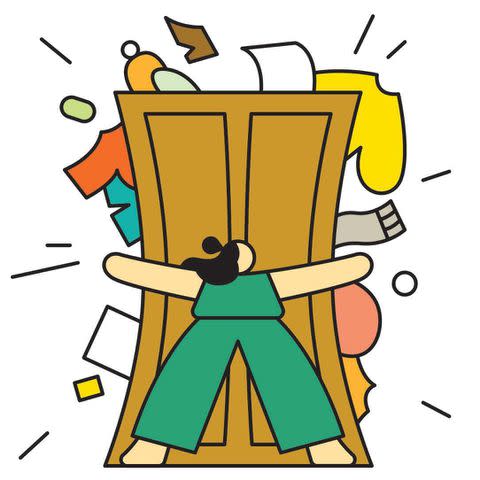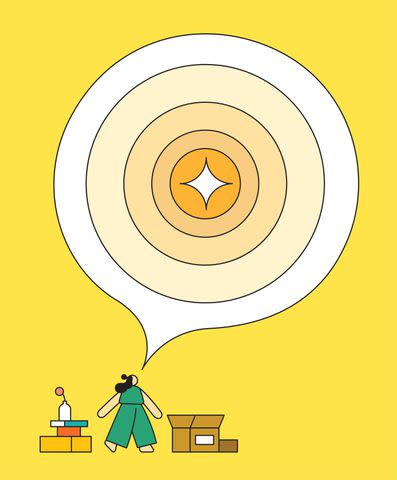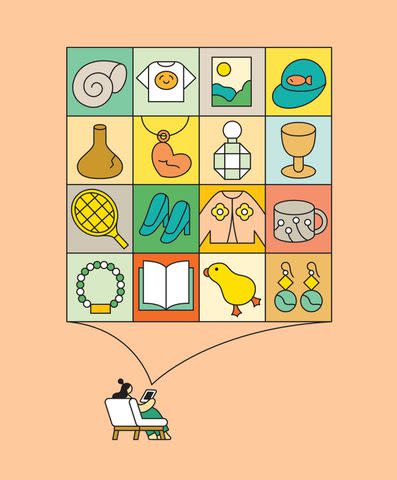16 Steps to Finally Declutter Your Home Once and for All
Clear out what’s taking up space in your home—and your mind.

Clutter tends to sneak up on you. One minute, you have a coat closet full (but not too full) of coats. The next, it’s bursting at the hinges with sports equipment, pet supplies, broken appliances, and, yeah, way too many puffers. How does it happen? Pretty easily! First, blame the gazillions of items available for two-day shipping. (Need a bathrobe for your dog? A pack of artificial lemons? Six dozen pink taper candles? They’re all just a few clicks away!)
Then there’s the human instinct to feel attached to your things, which makes it harder to part with them—especially if you’re the nostalgic type, says Carolyn Caldwell, a certified professional organizer based in Toronto who specializes in chronic disorganization. “People who are sentimental tend to assign equal importance to many, many things, and that makes it difficult for them to prioritize.” Even if you’re not emotionally invested in that ice cream machine, maybe you keep it around on the off chance you’ll need it someday, or because you like the idea of being someone who makes their own ice cream. Finally, it takes more effort to combat clutter than to accumulate it. Do nothing and things just pile up.
And all that stuff can have a huge impact on your life and happiness. What we’ve found is that the more clutter there is, the less sense of home you have—the less satisfaction and the more indecision.” We’re not just talking about an icky feeling but a concrete effect on your life, Dr. Joseph Ferrari, PhD says. “When the living space is impacted, it causes people stress and impairs their functioning.”
Maybe you have an unruly spice rack, a closet you’re scared to open, or too many piles. Whatever your issue, keep reading. We spoke with organizing and decluttering pros and gathered the best tips to get you started, keep you focused, and help you conquer Stuff Mountain for good.

State Your Goal
It’s tough to motivate yourself if you
can’t pinpoint why you’re doing something, says
Amy Tokos, a certified professional organizer based in Kansas City, Missouri. So identify
the reason you’re clearing out space—you need a spot to practice yoga, for example.
“If you’re struggling to decide whether to get rid of an item, ask, Is it more important than my
goal?” Tokos says. Set a deadline for achieving your aim; that should keep you on task.
Don't Buy Organizers
Not at first, anyway. “You won’t really know what you need until you dwindle down what you have,” Tokos says. Toss or donate your unwanted items, then see if you can repurpose some of your baskets and bins to corral your smaller stash. If your current collection of organizers isn’t working for you, then you can consider doing some shopping. Tip: Measure the shelves and drawers in question and bring those numbers with you.
Pick Low-Hanging Fruit
Different items come with different amounts of emotional baggage. Start with what’s easy (your abundance of muffin tins) and work your way toward the heavier stuff (your late dad’s old ties)
as you get into the swing of things.
Give Items an Expiration Date

Scared to part with something in case you’ll need it later? Put it aside in a cardboard box labeled with a future date—two weeks from now, three months, a year, whenever. If you haven’t used the item by that time, it’s got to go, says Anita Yakota, a therapist turned interior designer. “If you decide to save it, there has to be a purpose for it.”
Set a Timer for 15 Minutes
Spend just 900 seconds each day clearing stuff out. “It will give you confidence in your ability to shed and strengthen your decision-making muscles,” Caldwell says. The more often you make the call to toss or donate something, the easier it will get. Promise.
Pick 5 Things a Day
Every day, look around your house and move five items to the donate pile or the trash. At the end of the month, that’ll be 150 things! If you don’t have
a ton to declutter, make it one item per day; you’ll still get rid of 30-ish items a month.
Focus on a Single Spot
Target one tiny area you can finish in one little chunk of time. Tokos suggests something like a kitchen drawer. You might be inspired by the momentum and move on to tackle a second (and third!) small area.
Put a Number on It
How many is too many pairs of earrings?
Count out your collection to gain perspective. Let’s say you have more than 150 pairs of earrings—that means you could go almost half the year before rewearing a pair. And like all of us, you probably wear your favorites again and again. So if you donated 10% of your collection, you likely wouldn’t even feel it!
Invite a Friend to Hang Out
Having company over to support you while you complete a task can be super motivating. “Whether it’s the accountability factor or the energy of another person, it can help,” Caldwell says. While they’re there, ask them to hold the stuff for you, rather than touching it yourself: Ferrari says making physical contact with an item can intensify your emotional connection to it. Your BFF can lift up one thing at a time, and you can make a more objective ruling about keeping it or donating it. It might just be easier than expected to choose the latter.
Think to Yourself: What's the Cost of Keeping This Item?
Many of us fear we’ll toss something only to have to buy it again later, when we realize we actually need it. That said, holding on to things comes at a price too. How much do you spend on maintenance? Does the item take up valuable space in your home? Tokos reminds us that there’s also an emotional weight—we can feel heavier when we have stuff we don’t need.
Remember This Phrase
"If everything's a treasure, nothing's a treasure." It’s hard to let go of sentimental items, like your kid’s first report card, their baby shoes, their 14 soccer trophies. But! If you keep all the things that have ever meant something to you, then which ones are truly special? “When you downsize, you’re saying, Here are the real treasures that represent who I am and what I want to share with people,” Tokos explains.
Break Up a Set
Just because you inherited three cabinets’ worth of your grandma’s dishes doesn’t mean you have to keep all of them. “Select key pieces and let the rest go,” Caldwell says. It’s not an all-or-nothing situation.
Make It More Fun
To quote a famous nanny with a magically large handbag, a spoonful of sugar helps the medicine go down. Chores are more fun when they’re paired with something less taxing. Listen to your favorite playlist or pick up your go-to coffee shop drink to sip on while you sort. “Match up decluttering with something you love, and then you can associate it with good times and good things,” Caldwell says.
Identify Trigger Items... and Skip Them for Now
Lots of emotions are tied up in our things—love, pride, grief, anger, etc. If, while you’re decluttering, you come across something that makes you extra emotional, put it in a box, label it, and move on to something else. You don’t have to deal with it right now. Come back to it in an hour, a month, or when you feel ready.
Actually Donate Your Donations
It seems like every home in America has one: a bag of stuff for Goodwill, sitting and waiting for drop-off. The trick is to put that bag somewhere annoying, like in the entryway, so you nearly trip over it every time you leave. Or in the passenger seat of your car, so you have to stare at it when you drive to work. “If you make it a little painful, you won’t forget to deal with it,” Tokos says.
Hold On to Memories, Not Stuff

You can keep moments alive without stockpiling bulky mementos. Take a photo of an item or, better yet, a pic of yourself with the item! And save that (uploaded to your computer or the cloud) instead. “Keep the memory, keep the sentiment, but don’t necessarily keep the object,” Caldwell says.
For more Real Simple news, make sure to sign up for our newsletter!
Read the original article on Real Simple.

